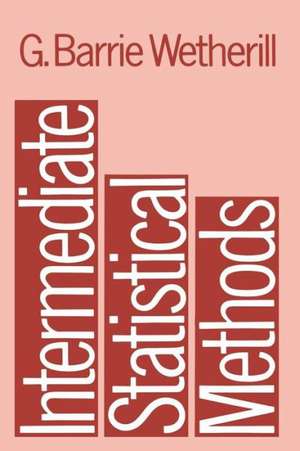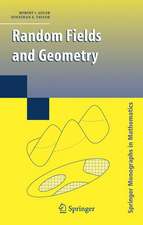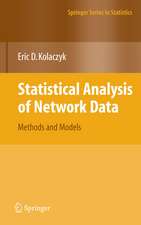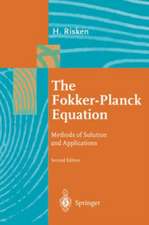Intermediate Statistical Methods
Editat de G. Barrie Wetherillen Limba Engleză Paperback – 18 iun 1981
Preț: 394.51 lei
Nou
Puncte Express: 592
Preț estimativ în valută:
75.50€ • 78.53$ • 62.33£
75.50€ • 78.53$ • 62.33£
Carte tipărită la comandă
Livrare economică 14-28 aprilie
Preluare comenzi: 021 569.72.76
Specificații
ISBN-13: 9780412164507
ISBN-10: 0412164507
Pagini: 392
Ilustrații: XVI, 392 p.
Dimensiuni: 155 x 235 x 21 mm
Greutate: 0.57 kg
Editura: SPRINGER NETHERLANDS
Colecția Springer
Locul publicării:Dordrecht, Netherlands
ISBN-10: 0412164507
Pagini: 392
Ilustrații: XVI, 392 p.
Dimensiuni: 155 x 235 x 21 mm
Greutate: 0.57 kg
Editura: SPRINGER NETHERLANDS
Colecția Springer
Locul publicării:Dordrecht, Netherlands
Public țintă
ResearchCuprins
1 Some properties of basic statistical procedures.- 1.1 Problems of statistics.- 1.2 The t, X2 and F procedures.- 1.3 Standard assumptions and their plausibility.- 1.4 Tests of normality.- 1.5 Moments of $$\bar{x}$$ and s2.- 1.6 The effect of skewness and kurtosis on the t-test.- 1.7 The effect of skewness and kurtosis on inferences about variances.- 1.8 The effect of serial correlation.- 1.9 The effect of unequal variances on the two-sample t-test.- 1.10 Discussion.- Further reading.- 2 Regression and the linear model.- 2.1 Linear models.- 2.2 The method of least squares.- 2.3 Properties of the estimators and sums of squares.- 2.4 Further analysis of Example 2.1.- 2.5 The regressions of y on x and of x on y.- 2.6 Two regressor variables.- 2.7 Discussion.- 3 Statistical models and statistical inference.- 3.1 Parametric inference.- 3.2 Point estimates.- 3.3 The likelihood function.- 3.4 The method of maximum likelihood.- 3.5 The Cramér — Rao inequality.- 3.6 Sufficiency.- 3.7 The multivariate normal distribution.- 3.8 Proof of the Cramér — Rao inequality.- Further reading.- 4 Properties of the method of maximum likelihood.- 4.1 Introduction.- 4.2 Formal statements of main properties.- 4.3 Practical aspects — one-parameter case.- 4.4 Practical aspects — multiparameter case.- 4.5 Other methods of estimation.- 5 The method of least squares.- 5.1 Basic model.- 5.2 Properties of the method.- 5.3 Properties of residuals.- 5.4 Properties of sums of squares.- 5.5 Application to multiple regression.- Further reading.- 6 Multiple regression: Further analysis and interpretation.- 6.1 Testing the significance of subsets of explanatory variables.- 6.2 Application of the extra sum-of-squares principle to multiple regression.- 6.3 Problems of interpretation.- 6.4Relationships between sums of squares.- 6.5 Departures from assumptions.- 6.6 Predictions from regression.- 6.7 Strategies for multiple regression analysis.- 6.8 Practical details.- Further reading on practical points.- 7 Polynomial regression.- 7.1 Introduction.- 7.2 General theory.- 7.3 Derivation of the polynomials.- 7.4 Tables of orthogonal polynomials.- 7.5 An illustrative example.- 8 The use of transformations.- 8.1 Introduction.- 8.2 One explanatory variable.- 8.3 Transformations for homogeneity of variance.- 8.4 An example.- 8.5 The Box—Cox transformation.- 8.6 Transformations of regressor variables.- 8.7 Application to bioassay data.- Further reading.- 9 Correlation.- 9.1 Definition and examples.- 9.2 Correlation or regression?.- 9.3 Estimation of ?.- 9.4 Results on the distribution of R.- 9.5 Confidence intervals and hypothesis tests for ?.- 9.6 Relationship with regression.- 9.7 Partial correlation.- 9.8 The multiple correlation coefficient.- Further reading.- 10 The analysis of variance.- 10.1 An example.- 10.2 Generalized inverses.- 10.3 Least squares using generalized inverses.- 10.4 One-way classification analysis of variance.- 10.5 A discussion of Example 10.1.- 10.6 Two-way classification.- 10.7 A discussion of Example 10.2.- 10.8 General method for analysis of variance.- Further reading.- 11 Designs with regressions in the treatment effects.- 11.1 One-way analysis.- 11.2 Parallel regressions.- 11.3 The two-way analysis.- 12 An analysis of data on trees.- 12.1 The data.- 12.2 Regression analyses.- 12.3 The analysis of covariance.- 12.4 Residuals.- 13 The analysis of variance: Subsidiary analyses.- 13.1 Multiple comparisons: Introduction.- 13.2 Multiple comparisons: Various techniques.- 13.3 Departures from underlying assumptions.- 13.4 Tests forheteroscedasticity.- 13.5 Residuals and outliers.- 13.6 Some points of experimental design: General points.- 13.7 Some points of experimental design: Randomized blocks.- Further reading on experimental design.- 14 Components of variance.- 14.1 Components of variance.- 14.2 Components of variance: Follow-up analysis.- 14.3 Nested classifications.- 14.4 Outline analysis of Example 14.3.- 14.5 Nested classifications: Finite population model.- 14.6 Sampling from finite populations.- 14.7 Nested classifications with unequal numbers.- Further reading.- 15 Crossed classifications.- 15.1 Crossed classifications and interactions.- 15.2 More about interactions.- 15.3 Analysis of a two-way equally replicated design.- 15.4 An analysis of Example 15.1.- 15.5 Unit errors.- 15.6 Random-effects models.- 15.7 Analysis of a two-way unequally replicated design.- Further reading.- 16 Further analysis of variance.- 16.1 Three-way crossed classification.- 16.2 An analysis of Example 16.1.- Further reading.- 17 The generalized linear model.- 17.1 Introduction.- 17.2 The maximum likelihood ratio test.- 17.3 The family of probability distributions permitted.- 17.4 The generalized linear model.- 17.5 The analysis of deviance.- 17.6 Illustration using the radiation experiment data.- Further reading.- References.












